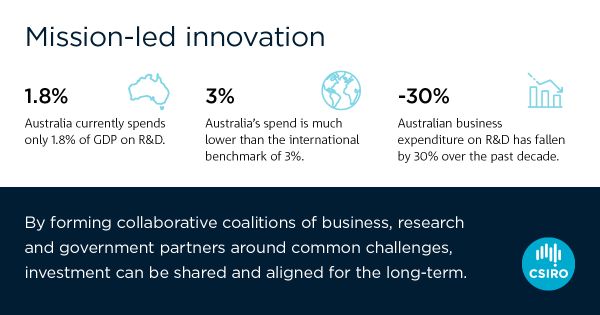Published on the 12/11/2020 | Written by Heather Wright

Science and tech light the path forward for Australian business…
Declining investment in R&D and wariness of new technologies are hampering Australian businesses, and leading to economic slowdown and a weakening economy, CSIRO says.
But refocusing attention on science on technology innovation can address Australia’s stagnating productivity and slowing economic growth, the national science agency says.
Its The Value of Science and Technology report says innovation investment has declined 30 percent in the past decade with companies investing smaller amounts on shorter term goals. At the same time, Australian organisations are struggling to commercialise breakthroughs in the lab into innovative products in market, exacerbated by a ‘cultural aversion to risk and low collaboration between research and industry’.
“If businesses act now, there are plenty of opportunities to enhance how they navigate the innovation cycle and realise greater value from their investments.”
The ongoing skills gap and a lack of ongoing training for employees outside of formal education, resistance to overseas ideas – with Australian companies happy to invest in keeping up with local competitors but rarely bothering about overseas competitors – and a wariness to invest in new technologies are all playing a hand in dragging down the country’s productivity and economic growth.
CSIRO notes that after three decades of economic growth, the economy had been showing signs of weakness and cause for concern, including low economic growth, low productivity growth and low business investment, in the last few years, pre-Covid and this year’s devastating bushfires. GDP grew just two percent in 2018-19 – the lowest rate in a decade.
CSIRO Futures lead economist Dr Katherine Wynn, says science and technology have always played a key role in supporting Australia’s growth and productivity.
She points to examples like the Cochlear hearing implants, Google Maps and biofuel.
“As investment in innovation has dropped in recent years, we’ve seen our economy start to slow and weaken, and now we’ve been hit with COVID-19, so science and technology are more critical than ever.
“If businesses act now, there are plenty of opportunities to enhance how they navigate the innovation cycle and realise greater value from their investments, including improved productivity, protection from market shocks, stronger international competitiveness, and social and environmental benefits.”
So what’s a business to do?
The report says businesses have a vital role in driving science and technology innovation and can realise significant value from doing so.
“Through innovation, businesses can create new products and services, increase the quality of existing goods and services, and be more productive and profitable,” it says.
“Innovation can also enable businesses to become more competitive internationally. Innovation aimed towards achieving social and environmental objectives can help businesses maintain a social licence to operate. Innovation can also help businesses manage their internal and external risks better and generate spillover effects within industrial clusters.
It calls for mission-led innovation, with collaborative coalitions of business, research and government partners based around common challenges. It’s an approach CSIRO says can encourage increased investment and more efficiently allocate existing investment while also enabling the coalitions to seize emerging opportunities.
“Australian businesses can extend beyond traditionally competitive sectors (mining, agriculture, education and tourism) and strategically diversify their focuses to increase economic complexity, support emerging industries and carve out niches in global value chains.
“There are considerable short, medium and long term growth opportunities in advanced technological industries such as advanced manufacturing, medical technologies and quantum technologies, which directly address social needs in areas of health, food and sustainability.”
Focusing on solutions-focused research and dismantling silos and building stronger connections between researchers, entrepreneurs, business, investors and education providers is also called for, with CSIRO saying that approach will enable ideas to move through to commercialisation.
A CSIRO and University of Queensland survey of ASX businesses this year found that top performing businesses collaborate broadly across several channels, including suppliers and customers, university partners and public and private research organisations.
“Breadth of collaboration was a key driver of these businesses’ performance and was 11 times higher for the top-performing businesses compared to the average-performing businesses,” the report notes.
An analysis from Swinburne University of Technology also found that engaging in collaborative research raised a business’s likelihood of undertaking innovation by 4.4 percentage points.
And collaboration needn’t be just local either. CSIRO is urging companies to ‘collaborate to compete’ by looking beyond borders.
“There is value to be captured by focusing on international collaboration to remain competitive, while also focusing our national resources around areas of unique value and global differentiation.”
When it comes to the wariness of new technologies, CSIRO says the impetus to adopt and diffuse new technologies is driven in part by attitudes including perceptions of risk regarding technological disruption and change.
“For instance, a Deloitte study found that only 22 percent of Australian executives likely to face disruption from AI were willing to develop and adopt AI, compared with 55% of executives in China, 47% in Germany and 44% in the United Kingdom.
“These adoption trends and attitudes may reflect a lower capacity to generate innovations that could yield large economic impacts.”
Yet adopting more S&T innovations from overseas and diffusing via continuous, incremental improvements and non-R&D innovation (including things like marketing products as high-quality, clean and green and increasing foreign demand, notably from China) can help capture greater benefits from innovation, the report says.
“Businesses can take several complementary strategies at once: Adopt more innovations from overseas and across industries; improve product and process quality at the margins by ‘tinkering’; and keep track of new S&T innovation opportunities to remain innovation-ready,” the report says.
“During this Covid-19 crisis, Australian businesses have an opportunity to reflect on their long-term goals, to make decisions aligned to achieving them, and to determine how to use S&T innovation as part of the solution.
“Now is the time to overcome complacency and reassess the validity of the long-held expectation that productivity and economic growth will continue without marked change. Australian businesses can set an agenda for mission-led innovation, supported by a cohesive strategy to build national capabilities and drive economic recovery and future resilience.”




























